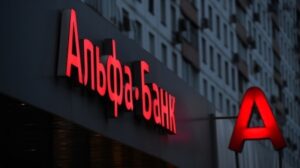
Alexey Blinov, head of the analytical department at Alfa-Bank, expects the stabilization of the hryvnia card rate for individuals in June and the preservation of the rates of exporters and importers.
“For June, we can predict the preservation of the rates of exporters and importers. As for the bank cash market for individuals, it has more or less stabilized and I don’t think that there will be such jumps that we saw this spring,” he said during the Finclub round table on Tuesday .
His opinion was shared by associate expert of “CASE Ukraine”, ex-deputy director of the financial stability department of the National Bank of Ukraine (NBU) Yevhen Dubogryz, who also noted the stabilization of the exchange rate compared to the jumps observed in the spring.
“It seems to me that we will have a creeping devaluation. Even if the NBU weighs this, there is still pressure on the hryvnia, since we have a war, problems with exports, with the fact that we do not receive the amount of funds from our partners, which we are very necessary,” the expert said.
He noted the existence of a small issue of the hryvnia, which affects inflation not directly, but through inflationary expectations.
“Over time, the NBU will change the course, of course, in the direction of the dollar’s rise in price,” Dubogryz pointed out.
As reported, on February 24, the National Bank suspended the work of the foreign exchange market of Ukraine, except for the sale of foreign currency, and fixed the exchange rate at the official level of that day – UAH 29.2549/$1, which led to the emergence of a “black” market, where in the first days the exchange rate reached 39-40 UAH/$1.
Later, the regulator allowed the sale of currency in branches under the threat of capture by the occupiers, by decision of their management, and from May 21, it canceled the upper limit of both the rate of selling cash currency by banks in Ukraine and the rate of converting the hryvnia into foreign currency on their cards outside the country. Previously, the ceiling for such an exchange rate was the official hryvnia exchange rate fixed on the first day of the war plus 10%, or UAH 32.18/$1. The ceiling for other currencies was calculated at the cross rate against the dollar.

Interest rates on deposits in 2020 will continue to decline and may reach 10% in the hryvnia and 1.5% in U.S. dollars, bankers said at a roundtable of the Financial Club on Thursday, May 21. “The trend to reduce interest rates will be examined until the end of the year. Interest rates will decrease,” Board Chairman at Idea Bank Mykhailo Vlasenko said, specifying that the bank’s current interest rates at 12-14% may drop to 8-10%.In turn, Capital Markets Director at Alfa-Bank Tetiana Popovych expects interest rates not to fall below 10%.
“Rates will drop, but in the short and medium term, I still see two-digit rates,” she said.
According to Deputy Board Chairman of TAScombank Oleh Poliak, the financial institution maintains deposit rates in hryvnias at about 11%, and in U.S. dollars at 2%.
“The trend is going down, I think it will remain at the level of 10-11%, in U.S. dollars will be about 1.5-2%,” the expert said.
Chief of the retail business department at Globus Bank Dmytro Zamotayev said that the bank lowered rates last week and plans to continue to decline following the market.
“We want to see the average interest rate about 10%, the ceiling rate of 11% at the end of summer,” he said.
Zamotayev said that at the moment the ceiling passive rate of Globus Bank is 12.75%.
“The rate in hryvnias will be around 11% by the end of June, and if we talk about the currency, when we made the forecast, it will be about 1.5% in U.S. dollars,” deputy chairman of the board at Forward Bank Andriy Prusov said.
He also said that during the lockdown period, about 90% of customers began to place deposits through Internet banking.
According to financial director at Alliance Bank Taras Kravets, the rate may reach 12% by the end of 2020.
“I will support my colleagues that the cost will decrease, but how fast it will depend on how quickly the economy overcomes the effects of the virus,” he said.According to Poliak, it is very important what kind of financial institutions take the first step in lowering rates.
“I believe that these should be state-owned banks, because they have the support of the government,” he said.
The expert believes that lowering rates in the future to 7-8% will not entail the active customer attrition if they see that the bank that serves them provides the customers with a market offer.
Prusov shared his opinion, who believes that lowering rates will not be an obstacle for customers and they will continue to place deposits in hryvnias in banks.
“I would like to say in confirmation of these words that according to the statistics of the NBU, it is obvious that over the last years, customers have placed more funds in hryvnias in banks, even without interest at all. In fact, trust is growing, and there are on-demand deposits on current accounts and their amount is growing every year,” he said.